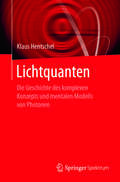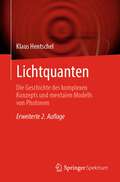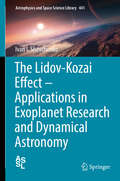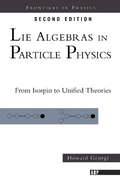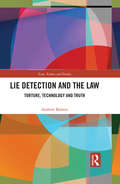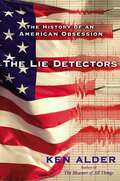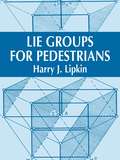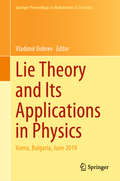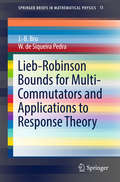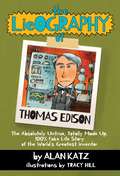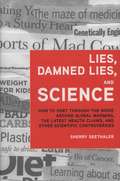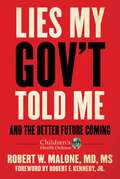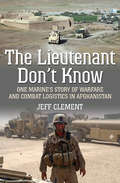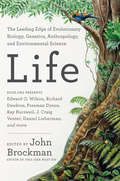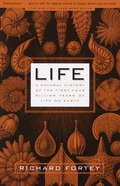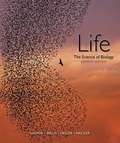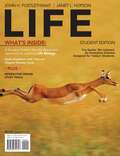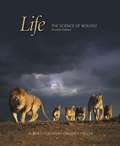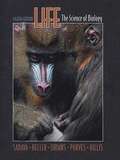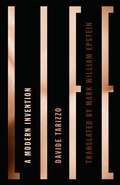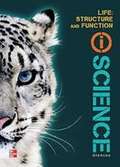- Table View
- List View
Lichtquanten: Die Geschichte des komplexen Konzepts und mentalen Modells von Photonen
by Klaus HentschelDieses Buch besch#65533;ftigt sich mit der Entstehungsgeschichte des komplexen Konzeptes des Photons aus wissenschaftshistorischer, kognitionspsychologischer und naturwissenschaftlicher Sicht. Dabei werden unter anderem sechs verschiedene mentale Modelle des Lichtquantums bzw. Photons diskutiert und der Bogen vom Teilchenmodell Newtons, dem Singularit#65533;tsmodell Einstein und Bohrs bis zum modernen Konzept der Quantisierung des elektromagnetischen Feldes in der Quantenelektrodynamik gespannt. Der Autor besch#65533;ftigt sich zuerst mit der Entwicklungsgeschichte des Photons innerhalb der modernen Physik ab 1900, bevor er die zw#65533;lf semantischen Bedeutungsschichten des Photons ausgehend vom Anfang des 20. Jahrhunderts pr#65533;sentiert. Anschlie#65533;end werden die mentalen Modelle im Laufe der Geschichte bis zur Moderne beschrieben und diskutiert und das heutige Modell des Photons besprochen. Das Buch richtet sich sowohl an Naturwissenschaftler mit physikalischem Hintergrund als auch an Wissenscha ftshistoriker und Andere, die sich mit der Begriffs- und Ideengeschichte von Konzepten auseinandersetzen.
Lichtquanten: Die Geschichte des komplexen Konzepts und mentalen Modells von Photonen
by Klaus HentschelDieses Buch beschäftigt sich mit der Entstehungsgeschichte des komplexen Konzeptes von Photonen aus wissenschaftshistorischer, kognitionspsychologischer und naturwissenschaftlicher Sicht. Dabei werden unter anderem sechs verschiedene mentale Modelle des Lichtquantums bzw. Photons diskutiert. Der Bogen wird vom Teilchenmodell Newtons, dem Singularitätsmodell Einsteins und Bohrs bis zum modernen Konzept der Quantisierung des elektromagnetischen Feldes in der Quantenelektrodynamik gespannt. Der Autor beschäftigt sich zuerst mit der Entwicklungsgeschichte des Photons innerhalb der modernen Physik ab 1900, bevor er zwölf Bedeutungsschichten des Photons ausgehend vom Anfang des 20. Jahrhunderts präsentiert. Anschließend werden die mentalen Modelle des quantisierten Lichts diskutiert und das heutige Modell des Photons besprochen.Die deutlich erweiterte zweite Auflage des Buches wurde unter anderem durch zusätzliche Abschnitte über semiklassische Theorien, Dirac, QED und über die Feynman Lectures ergänzt. Ferner wurde das Kapitel über verschiedene Modelle der Begriffsentwicklung und den hier vertretenen Ansatz der Suche nach mentalen Modellen stark erweitert. Das Buch richtet sich sowohl an Naturwissenschaftler wie auch an Wissenschaftshistoriker und Andere, die sich mit der Begriffs- und Ideengeschichte von Konzepten auseinandersetzen.
The Lidov-Kozai Effect - Applications in Exoplanet Research and Dynamical Astronomy
by Ivan I. ShevchenkoThis book deals with an effect in celestial mechanics that has become quite important in exoplanet research. The Lidov-Kozai effect reveals itself in coherent periodic variations (which can be very large) of the inclination and eccentricity of an orbiting body in the presence of an inclined perturber. The effect is known to be important in the motion of many asteroids and planetary satellites. What is more, now it attracts more and more interest in the astronomical and astrophysical community due to its relevance for many exoplanetary systems. Recent years witnessed major advancements in its theory. It would be no exaggeration to say that nowadays the Lidov-Kozai effect becomes one of the most studied astrophysical effects. This book covers the multitude of the Lidov-Kozai effect's modern applications and its theory developments. It will be useful for any person working in astrophysics, celestial mechanics, stellar dynamics, theoretical mechanics, space missions design, at any level (researcher, graduate student, undergraduate student), depending on the interests of the reader. The book is self-contained. It provides the full detailed coverage of the effect's theory and applications.
Lie Algebras In Particle Physics
by Howard GeorgiHoward Georgi is the co-inventor (with Sheldon Glashow) of the SU(5) theory. This extensively revised and updated edition of his classic text makes the theory of Lie groups accessible to graduate students, while offering a perspective on the way in which knowledge of such groups can provide an insight into the development of unified theories of strong, weak, and electromagnetic interactions.
Lie Algebras In Particle Physics
by Howard GeorgiHoward Georgi is the co-inventor (with Sheldon Glashow) of the SU(5) theory. This extensively revised and updated edition of his classic text makes the theory of Lie groups accessible to graduate students, while offering a perspective on the way in which knowledge of such groups can provide an insight into the development of unified theories of strong, weak, and electromagnetic interactions.
Lie Algebras In Particle Physics
by Howard GeorgiGeorgi's Harvard lectures (he's taught physics there since 1980) discuss application of the theory of Lie Algebras and their representations to a wide variety of problems in particles physics and quantum mechanics. This edition has been expanded to include more extensive discussion of finite group theory and representations of the permutation group, as well as discussion of new subjects such as Dynkin indices, spontaneous symmetry breaking, lepton number as a fourth color, and the 27-dimensional representation of E(6). Annotation c. Book News, Inc. , Portland, OR (booknews. com)
Lie Algebras In Particle Physics
by Howard GeorgiHoward Georgi is the co-inventor (with Sheldon Glashow) of the SU(5) theory. This extensively revised and updated edition of his classic text makes the theory of Lie groups accessible to graduate students, while offering a perspective on the way in which knowledge of such groups can provide an insight into the development of unified theories of strong, weak, and electromagnetic interactions.
Lie Detection and the Law: Torture, Technology and Truth (Law, Science and Society)
by Andrew BalmerThis book develops a sociological account of lie detection practices and uses this to think about lying more generally. Bringing together insights from sociology, social history, socio-legal studies and science and technology studies (STS), it explores how torture and technology have been used to try to discern the truth. It examines a variety of socio-legal practices, including trial by ordeal in Europe, the American criminal jury trial, police interrogations using the polygraph machine, and the post-conviction management of sex offenders in the USA and the UK. Moving across these different contexts, it articulates how uncertainties in the use of lie detection technologies are managed, and the complex roles they play in legal spaces. Alongside this story, the book surveys some of the different ways in which lying is understood in philosophy, law and social order. Lie Detection and the Law will be of interest to STS researchers, socio-legal scholars, criminologists and sociologists, as well as others working at the intersections of law and science.
The Lie Detectors: The History of an American Obsession
by Ken AlderThe story of the lie detector takes us straight into the dark recesses of the American soul. It also leads us on a noir journey through some of the most storied episodes in American history. That is because the device we take for granted as an indicator of guilt or innocence actually tells us more about our beliefs than about our deeds. The machine does not measure deception so much as feelings of guilt or shame. As Ken Alder reveals in his fascinating and disturbing account, the history of the lie detector exposes fundamental truths about our culture: why we long to know the secret thoughts of our fellow citizens; why we believe in popular science; and why America embraced the culture of "truthiness." For centuries, people searched in vain for a way to unmask liars, seeking clues in blushing cheeks, shifty eyes, and curling toes. . . all the body's outward signs. But not until the 1920s did a cop with a Ph.D. team up with an entrepreneurial high school student from Berkeley, California and claim to have invented a foolproof machine that peered directly into the human heart. In a few short years their polygraph had transformed police work, seized headlines, solved sensational murders, and enthralled the nation. In Chicago, the capital of American vice, the two men wielded their device to clean up corruption, reform the police, and probe the minds of infamous killers. Before long the lie detector had become the nation's "mechanical conscience," searching for honesty on Main Street, in Hollywood, and even within Washington, D.C. Husbands and wives tested each other's fidelity. Corporations tested their employees' honesty. Movie studios and advertisers tested their audiences' responses. Eventually, thousands of government employees were tested for their loyalty and "morals" -- for lack of which many lost their jobs. Yet the machine was flawed. It often was used to accuse the wrong person. It could easily be beaten by those who knew how. Repeatedly it has been applied as an instrument of psychological torture, with the goal of extracting confessions. And its creators paid a commensurate price. One went mad trying to destroy the Frankenstein's monster he had created. The other became consumed by mistrust: jealous of his cheating wife, contemptuous of his former mentor, and driven to an early death. The only happy man among the machine's champions was the eccentric psychologist who went on to achieve glory as the creator of Wonder Woman. Yet this deceptive device took America -- and only America -- by storm. Today, the CIA still administers polygraphs to its employees. Accused celebrities loudly trumpet its clean bill of truth. And the U.S. government, as part of its new "war on terror," is currently exploring forms of lie detection that reach directly into the brain. Apparently, America still dreams of a technology that will render human beings transparent. The Lie Detectors is the entertaining and thought-provoking story of that American obsession.
Lie Groups for Pedestrians
by Harry J. LipkinAccording to the author of this concise, high-level study, physicists often shy away from group theory, perhaps because they are unsure which parts of the subject belong to the physicist and which belong to the mathematician. However, it is possible for physicists to understand and use many techniques which have a group theoretical basis without necessarily understanding all of group theory. This book is designed to familiarize physicists with those techniques. Specifically, the author aims to show how the well-known methods of angular momentum algebra can be extended to treat other Lie groups, with examples illustrating the application of the method.Chapters cover such topics as a simple example of isospin; the group SU3 and its application to elementary particles; the three-dimensional harmonic oscillator; algebras of operators which change the number of particles; permutations; bookkeeping and Young diagrams; and the groups SU4, SU6, and SU12, an introduction to groups of higher rank. Four appendices provide additional valuable data.
Lie Theory and Its Applications in Physics: Varna, Bulgaria, June 2019 (Springer Proceedings in Mathematics & Statistics #335)
by Vladimir DobrevThis volume presents modern trends in the area of symmetries and their applications based on contributions to the workshop "Lie Theory and Its Applications in Physics" held near Varna (Bulgaria) in June 2019. Traditionally, Lie theory is a tool to build mathematical models for physical systems. Recently, the trend is towards geometrization of the mathematical description of physical systems and objects. A geometric approach to a system yields in general some notion of symmetry, which is very helpful in understanding its structure. Geometrization and symmetries are meant in their widest sense, i.e., representation theory, algebraic geometry, number theory, infinite-dimensional Lie algebras and groups, superalgebras and supergroups, groups and quantum groups, noncommutative geometry, symmetries of linear and nonlinear partial differential operators, special functions, and others. Furthermore, the necessary tools from functional analysis are included. This is a large interdisciplinary and interrelated field. The topics covered in this volume from the workshop represent the most modern trends in the field : Representation Theory, Symmetries in String Theories, Symmetries in Gravity Theories, Supergravity, Conformal Field Theory, Integrable Systems, Polylogarithms, and Supersymmetry. They also include Supersymmetric Calogero-type models, Quantum Groups, Deformations, Quantum Computing and Deep Learning, Entanglement, Applications to Quantum Theory, and Exceptional Quantum Algebra for the standard model of particle physics This book is suitable for a broad audience of mathematicians, mathematical physicists, and theoretical physicists, including researchers and graduate students interested in Lie Theory.
Lieb-Robinson Bounds for Multi-Commutators and Applications to Response Theory
by J. B. Bru W. de Siqueira PedraLieb-Robinson bounds for multi-commutators are effective mathematical tools to handle analytic aspects of infinite volume dynamics of non-relativistic quantum particles with short-range, possibly time-dependent interactions. In particular, the existence of fundamental solutions is shown for those (non-autonomous) C*-dynamical systems for which the usual conditions found in standard theories of (parabolic or hyperbolic) non-autonomous evolution equations are not given. In mathematical physics, bounds on multi-commutators of an order higher than two can be used to study linear and non-linear responses of interacting particles to external perturbations. These bounds are derived for lattice fermions, in view of applications to microscopic quantum theory of electrical conduction discussed in this book. All results also apply to quantum spin systems, with obvious modifications. In order to make the results accessible to a wide audience, in particular to students in mathematics with little Physics background, basics of Quantum Mechanics are presented, keeping in mind its algebraic formulation. The C*-algebraic setting for lattice fermions, as well as the celebrated Lieb-Robinson bounds for commutators, are explained in detail, for completeness.
The Lieography of Thomas Edison: The Absolutely Untrue, Totally Made Up, 100% Fake Life Story of the World's Greatest Inventor (Lieographies Ser. #1)
by Alan KatzThomas Edison, world-class inventor. You might know that he devised the electric light bulb and the phonograph. But what about his development of train-controlling sticks? Or his airborne way to send pancakes to his Cousin Fran in Texas? You&’re about to be treated to the Lieographical aspects of Thomas Edison&’s life, in this funny, lighthearted, &“all that didn&’t happen&” take on the man whose inventions transformed our daily existence. The book ends with a short—but true—account of Edison&’s life—just enough to encourage kids to find out more on this important historical figure. But even if readers have already learned about Edison, the wacky stories in this tall-tales book will be even more enjoyable.
Lies, Damned Lies, and Science: How to Sort Through the Noise Around Global Warming, the Latest Health Claims, and Other Scientific Controversies
by Sherry SeethalerDon't get hoodwinked: make sense of news. . . and make smarter decisions for yourself, your family, and the world! Objective, balanced techniques for thinking about everything from diet and drugs to climate change. Identifying and getting past the biases of politicians, lobbyists, marketers. . . and even some scientific and medical professionals. By scientist Dr. Sherry Seethaler, one of the world's most respected and innovative science educators.
Lies My Gov't Told Me: And the Better Future Coming (Children’s Health Defense)
by Robert W. Malone**AS SEEN ON TUCKER CARLSON TODAY AND THE JOE ROGAN EXPERIENCE**A guide for the times—breaking down the lies about COVID-19 and shedding light on why we came to believe them. When he invented the original mRNA vaccine technology as a medical and graduate student in the late 1980s, Robert Malone could not have imagined that he would become a leader in a movement to expose the dangers of mRNA vaccines that billions of people have received—too often without being informed of the risks. For voicing opposition to the &“mainstream&” narrative, Dr. Robert Malone was censored by Big Tech and vilified by the media. But he continues to speak out and alert the world to the web of lies that we have all experienced. From vaccine safety and effectiveness to early treatments like ivermectin, to lockdowns, masks, and more, Dr. Malone is the signature dissident voice telling the other side of the story about COVID, the role of corporate media, censorship, propaganda, and the brave new world of transhumanism promoted by the World Economic Forum and its acolytes. What effect did the COVID policies have on lives, livelihoods, and democracies? How is it possible that the lies spread by governments would persist, and that our institutions would fail to correct them? Lies My Gov&’t Told Me takes a hard look at these questions and illustrates how data, information, and psychology have been distorted during the pandemic. Governments intentionally weaponized fear to mold behavior. The media smeared anyone who objected to the narrative. And Big Pharma—aligned with larger globalist interests exemplified by the likes of Bill Gates and the World Economic Forum—had captured the agencies that are supposed to regulate it long before the pandemic began. Dr. Malone explores these perverse connections between Pharma, government, and media, and tells us what can be done about it. With contributed chapters from other leading thinkers, such as Dr. Paul Marik and Professor Mattias Desmet, and drawing upon history, psychology, and economics, Lies My Gov&’t Told Me looks at COVID from numerous angles. Never satisfied with a simple answer or easy solution, Dr. Malone proposes multiple action plans for a better future. Dr. Malone calls on each of us to find our own solutions, our own ways to resist the control of fascist, corporatist, and totalitarian overlords. If we are to step out of the darkness—toward a world that defends the principles of the Constitution, upholds individual rights, and honors free speech—we all must play a part in the transition.
The Lieutenant Don't Know: One Marine's Story of Warfare and Combat Logistics in Afghanistan
by Jeffrey Clement“A unique insight into the war experience . . . a realistic picture of what it is like to serve in Afghanistan as a Marine combat logistician” (Small Wars Journal).When he joined the Marines, Jeff Clement was not a high-speed, top-secret recon guy. A logistician instead, he led combat convoys across treacherous terrain in southern Afghanistan through frequent enemy attacks in order to resupply US and British positions. As such, he and his vehicles were a constant target for the resistance, and each movement was a travail, often accompanied by thundering blasts as the insurgents paved their way with IEDs. Every step forward was fraught with danger, even as each objective had to be met. As a Marine Corps lieutenant, he deployed to Afghanistan twice and always found a learning curve, as men previously on the ground were more savvy, and the insurgents, there for the duration, were savvier still.The Lieutenant Don’t Know provides a refreshing look at the nitty-gritty of what our troops have been dealing with in Afghanistan—from the perspective of a young officer who was perfectly willing to learn and take responsibility for his units in a confusing war where combat was not merely on the “front,” but all around and looking over all their roads.“Finally, a readable, honest and gritty account of the dangerous, exhausting labor that keeps ‘The Green Machine’ going.” —Bing West, New York Times–bestselling author of One Million Steps“One of the best war memoirs I’ve ever read . . . a moving, inspiring work, that’s enjoyable as hell, as well.” —Stan R. Mitchell, author of Gravel Road
Life: The Leading Edge of Evolutionary Biology, Genetics, Anthropology, and Environmental Science
by Mr John BrockmanThe newest addition to John Brockman's Edge.org series explores life itself, bringing together the world's leading biologists, geneticists, and evolutionary theorists--including Richard Dawkins, Edward O. Wilson, J. Craig Venter, and Freeman Dyson.Scientists' understanding of life is progressing more rapidly than at any point in human history, from the extraordinary decoding of DNA to the controversial emergence of biotechnology. Featuring pioneering biologists, geneticists, physicists, and science writers, Life explains just how far we've come--and takes a brilliantly educated guess at where we're heading.Richard Dawkins and J. Craig Venter compare genes to digital information, and sketch the frontiers of genomic research.Edward O. Wilson reveals what ants can teach us about building a superorganism--and, in turn, about how cells build an organism. Elsewhere, David Haig reports new findings on how mothers and fathers individually influence the human genome, while Kary Mullis covers cutting edge treatments for dangerous viruses. And there's much more in this fascinating volume.We may never have all the answers. But the thinkers collected in Life are asking questions that will keep us dreaming for generations.
Life: A Natural History of the First Four Billion Years of Life on Earth
by Richard ForteyBy one of Britain's most gifted scientists: a magnificently daring and compulsively readable account of life on Earth (from the "big bang" to the advent of man), based entirely on the most original of all sources--the evidence of fossils. With excitement and driving intelligence, Richard Fortey guides us from the barren globe spinning in space, through the very earliest signs of life in the sulphurous hot springs and volcanic vents of the young planet, the appearance of cells, the slow creation of an atmosphere and the evolution of myriad forms of plants and animals that could then be sustained, including the magnificent era of the dinosaurs, and on to the last moment before the debut of Homo sapiens. Ranging across multiple scientific disciplines, explicating in wonderfully clear and refreshing prose their findings and arguments--about the origins of life, the causes of species extinctions and the first appearance of man--Fortey weaves this history out of the most delicate traceries left in rock, stone and earth. He also explains how, on each aspect of nature and life, scientists have reached the understanding we have today, who made the key discoveries, who their opponents were and why certain ideas won. Brimful of wit, fascinating personal experience and high scholarship, this book may well be our best introduction yet to the complex history of life on Earth. A Book-of-the-Month Club Main Selection.
Life: The Science of Biology
by H. Craig Heller David M. Hillis Sally D. Hacker David E. SadavaThe Eleventh Edition of Life: The Science of Biology is engaging, active, and focused on teaching the skills that students need in the majors biology course. New pedagogical features grab students' attention and give them a clear learning path through the text. Active learning is a priority throughout the text and media, giving instructors the support they need to encourage students to "learn by doing." Life continues and improves its focus on experiments and data, ensuring that students learn the skills they need to succeed in their careers. It is this potent combination of expertly crafted pedagogy and engagement that make this new edition the best resource for biology students.The Eleventh Edition of Life: The Science of Biology retains its reputation as the book with the highest quality content, clarity of language, and experimental emphasis, and the new focus and features make it a Life worth investigating.
Life
by John H. Postlethwait Janet L. HopsonCreated through a "student-tested, faculty-approved" review process, LIFE is an engaging and accessible solution to accommodate the diverse lifestyles of today's learners. LIFE provides streamlined chapters, in-text support, and online tools to make learning more flexible.
Life: The Science Of Biology
by William K. Purves H. Craig Heller Gordon H. Orians David SadavaAuthoritative, thorough, and engaging, Life: The Science of Biology achieves an optimal balance of scholarship and teachability, never losing sight of either the science or the student. The first introductory text to present biological concepts through the research that revealed them, Life covers the full range of topics with an integrated experimental focus that flows naturally from the narrative. This approach helps to bring the drama of classic and cutting-edge research to the classroom--but always in the context of reinforcing core ideas and the innovative scientific thinking behind them. Students will experience biology not just as a litany of facts or a highlight reel of experiments, but as a rich, coherent discipline.
Life: The Science of Biology (4th edition)
by William K. Purves Gordon H. Orians H. Craig HellerThe science of biology evolves. The science classroom and lab evolve. In this edition, as always, Life: The Science of Biology evolves with them, in innovative, authoritative, and captivating ways. From the first edition to the present, Life has set the standard for being the most balanced experimentally-based introductory biology text.
Life: The Science of Biology 8th Edition
by Sadava H. Craig Heller William K. Purves David Sadava David HillisCo-published by Sinauer Associates, Inc. , and W. H. Freeman and Company. Visit the Life, Eighth Edition preview site. LIFE HAS EVOLVED. . . from its original publication to this dramatically revitalized Eighth Edition. LIFE has always shown students how biology works, offering an engaging and coherent presentation of the fundamentals of biology by describing the landmark experiments that revealed them. This edition builds on those strengths and introduces several innovations.
Life: A Modern Invention (Posthumanities #44)
by Davide TarizzoThe word &“biology&” was first used to describe the scientific study of life in 1802, and as Davide Tarizzo demonstrates in his reconstruction of the genealogy of the concept of life, our understanding of what being alive means is an equally recent invention. Focusing on the histories of philosophy, science, and biopolitics, he contends that biological life is a metaphysical concept, not a scientific one, and that this notion has gradually permeated both European and Anglophone traditions of thought over the past two centuries.Building on the work undertaken by Foucault in the 1960s and &‘70s, Tarizzo analyzes the slow transformation of eighteenth-century naturalism into a nineteenth-century science of life, exploring the philosophical landscape that engendered biology and precipitated the work of such foundational figures as Georges Cuvier and Charles Darwin. Tarizzo tracks three interrelated themes: first, that the metaphysics of biological life is an extension of the Kantian concept of human will in the field of philosophy; second, that biology and philosophy share the same metaphysical assumptions about life originally advanced by F. W. J. Schelling and adopted by Darwin and his intellectual heirs; and third, that modern biopolitics is dependent on this particularly totalizing view of biological life. Circumventing tired debates about the validity of science and the truth of Darwinian evolution, this book instead envisions and promotes a profound paradigm shift in philosophical and scientific concepts of biological life.
Life: Structure and Function
by The Editors at the McGraw Hill EducationThis book explains the Life's basic structure --Cell, its functions and other related topics like levels of organization,reproduction, Genetics etc.
